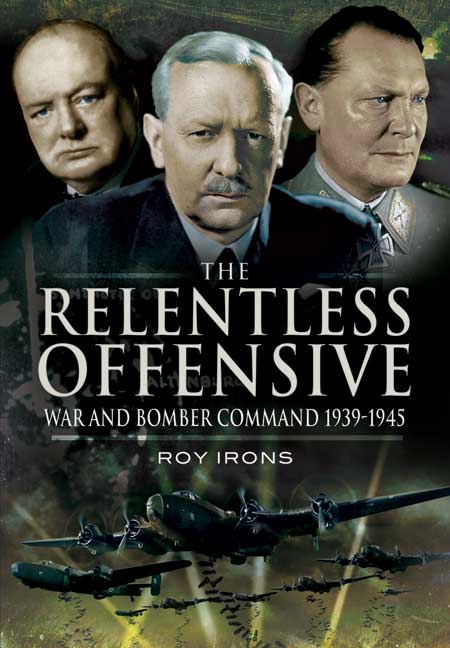The Relentless Offensive (ePub)
War & Bomber Command 1939-1945
Imprint: Pen & Sword Aviation
File Size: 622.3 KB (.epub)
ISBN: 9781844685028
Published: 1st April 2009
| Other formats available - Buy the Hardback and get the eBook for free! | Price |
|---|---|
| The Relentless Offensive Hardback Add to Basket | £19.99 |
During the years before World War II, the Royal Air Force, created amid the bloodshed of the Great War, saw salvation in the doctrine of a relentless offensive by a bomber force which would sail over trenches and then on to the enemy cities and annihilate the ability of the enemy to wage war. This book gives a view of how that doctrine, driven by courage and coldly sharpened by scientists, brought those visions to reality.
This is a fresh analysis of Bomber Command, its tactics and technology. It discusses exactly how well organised Bomber Command was to exploit the rapidly evolving new science and technology of new type of warfare. How much did the concept of Allied and German 'morale' influenced the Command's operational plans? What was the influence of the Research and Experiments Dept of the Ministry of Home Security and of university scientists such as Tizard and Cherwell? This book delves into the research into high-explosives and firebombing techniques, newly designed bombs and their devastating effect on the enemy. Why in the early war days was the RAF bomber's armament so ineffective, the navigation so imprecise and the bombing accuracy so poor?
This book also discusses the many varying moral issues that even to this day still rage between those who feel guilt for the destruction of so many German cities and those who see moral justification in the eventual Allied victory.
For those of you who wondered why so many problems dogged Bomber Command and its equipment during WW2 I would thoroughly recommend 'The Relentless Offensive: War and Bomber Command' by Roy Irons.
Historical Wings Society, Customer
This book details doctrine, research and armament development, and the foresight or lack thereof by individuals and various committees involved in making the Command a fighting force.
For those of you who wondered why so many problems dogged Bomber Command and its equipment during WW2 I would thoroughly recommend 'The Relentless Offensive: War and Bomber Command'
Historical Wings Society, customer
This book details doctrine, research and armament development, and the foresight or lack thereof by individuals and various committees involved in making the command a fighting force.
The Relentless Offensive covers an aspect of the WW2 Bomber Offensive which, as far as I know, has not been fully investigated before. How well did the scientists, the civil service and industry support Bomber Command to ensure that the bombing was as effective as possible?
John L. Cox DFC, Aerospace Professional - The magazine of the Royal Aeronautical Society
The author suggests, with the help of many official documents, that the expected support often did not appear with the urgency and commitment it deserved. He contrasts American ‘Can-do’ attitudes with British tardiness. As an example, he cites how the North American Aircraft Company was able to produce a prototype of the Mustang in just 119 days yet, when the UK Armament Department was asked to produce a new gun they estimated it would take them 15 years! Even Air Marshal Harris did not always realise how the ‘Non possum’ attitude of much of the armaments industry, planners and administration was not fully supporting his command.
The pre-war doctrine of the relentless offensive dwelt too much on a vision of panicking crowds and ruined cities, somehow the detail of how this would be achieved was not well thought out. The expansion of Bomber Command, from 400 medium bombers at the start of the war to eventually 1,800 heavy bombers at its end, was a great achievement. But perhaps a more telling statistic is that, during this time, 8,000 bombers were lost.
The author’s comments pose a number of questions. Why did we stick with inferior rifle-calibre (0.303in) machine guns, ineffective against armour, while the Americans used 0.5 calibre right from the start? It is estimated that 20% of British bombs just did not explode; was it really impossible to improve on this? Why were turrets with better clear-vision panels not fitted? Why did our incendiary bombs fall in a random scattering across the bomber stream instead of being more concentrated with aimable containers? Harris wrote that the failure to produce such a cluster device “enormously reduced the efficiency of our incendiary attacks”. Why was the effectiveness of the explosive used not improved by the simple means of adding aluminium (as done by the Royal Navy and the Germans)? Why was the need for a long-range escort fighter not pursued for the RAF? How grateful we were when the Americans provided them!
The survivors of Bomber Command (the few of us now left) may well weep to read that the back-up, which they assumed was there to support them, was all-too-often half-hearted or absent. How much more effective their efforts could have been, how many more of their lost comrades would have survived? This well-researched book has some of the answers.
"...The book concentrates on the 'paper' war within the Air Ministry, detailing the meetings and committee reports on various subjects relating to bombing and also the correspondence between the senior ranks of the Air Ministry and RAF as they tried to mould the decisions into a form they wished their areas of responsibility to adopt.
Air Britain
"...The author has done much digging into the files of the Air Ministry to extract minutes and correspondence to cover the subject and the sources are well detailed. This makes it an excellent source book for the 'admin' side of the bomber offensive."
It is something of a metaphor for the content of this book that it contains no illustrations. Instead, it is densely written, passionately argued and makes for demanding – and rewarding – reading. Forty years ago, the classrooms of the AF Language School rang with the assertion by émigré |Russian teachers that ‘repetition is the mother of learning’ and that technique is apparent in the pages of The Relentless Offensive. It is none the worse for that, because its arguments are complex and, ultimately, highly convincing.
Air Vice Marshal 'Sandy' Hunter, RAF Historical Society
Roy Irons develops a consistent theme of dereliction in the application of Trenchard’s doctrine of the offensive – the doctrine central to the survival of the Royal Air Force in the inter-war years. Those so charged failed to perform adequately in several discrete areas of the equipment and training of Bomber Command. This book identifies key instances in which such failures were allowed to happen as a result of dogmatism, muddled thinking and beaurocratic lethargy. He is broadly even handed in his censure of the Air Staff and of the specialist Armament Departments and the tale he tells has a relevance even today.
Three main areas of criticism emerge from Roy Irons’ researches, along with a number of cognate issues. He is not the first historian or commentator to highlight the weaknesses of defensive armament in Bomber Command’s principal aircraft types, right to the end of the Bomber Offensive. He employs a wealth of technical information to demonstrate his case, but he also illustrates the extent to which entrenched belief in the ability of the bomber to ‘get through’ clouded logical thought and analysis. In passing, it should be noted that he gives Tizard and Ludlow-Hewitt an unexpectedly good press, not least in their recognition that aircraft and crew losses would ultimately cause huge damage to the potential of Bomber Command. Tizard’s use of the measure of bombs on target per aircraft loss earns his especial approval and is fundamental to his assessment of the effects of inferior defensive armament and of the resulting aircraft losses.
Irons is equally critical of the lethargy and indifference of those charged with the development of effective bombs and, especially, of the failure of staffs to produce an incendiary cluster weapon. His detailed arguments are backed up by the typically colourful and acerbic comment of Sir Arthur Harris! Again, though, this is no mere outpouring of mere opinion on the part of Irons: his case is carefully argued and supported by fact.
The enforced recourse to night bombing that followed early failures by day leads Roy Irons to revisit the vexed question of escort fighter support for the bomber force. Here, he contrasts the effects of ultimate American success and the achievement of air superiority by day, with what he regards as British neglect. Inevitably, he returns to the Tizard formula to contrast bombing accuracies by day and night, the effects of electronic navigation and bombing aids notwithstanding. The measure of bombs on target is fundamental to his case.
The Relentless Offensive paints a compelling picture of a dysfunctional procurement system which continued on its uncertain path right until the end of WWII. Many would argue that the structures and attitudes that led to such a conclusion remained in place for many decades to follow. His particular bile is reserved for the Armament Departments of the Air Ministry and Ministry of Aircraft Production, but he is strongly critical of the Air Staff and of the part played, or not played, by its officers.
This is not a light or easy book to read, but its arguments are compelling and relevant even today. Irons argues that dogmatism, muddled thinking and bureaucratic lethargy caused unnecessary human loss in 1939-45 and flew in the face of the very compelling yardstick of bombs on target per aircraft loss. As a cautionary tale, The Relentless Offensive deserves a place on the bookshelves of many engaged in Defence Procurement today.
"well written and interesting throughout"
Prof Jeremy Black, The Historical Association
About Roy Irons
Roy Irons was born October 1938, went to Coopers' Company's School (now The Coopers' Company and Coburn School), did national service in the infantry (Northamptons). He joined British Gas 1963 and retired in1993. He then passed 3 A levels 1990-3 and obtained a degree in War Studies/History at King's College London 1993 - 1996. He has had published Hitler's Terror Weapons in 2002. He is married to Erica and has a daughter Rebecca. He lives Coulsdon, Surrey.
















